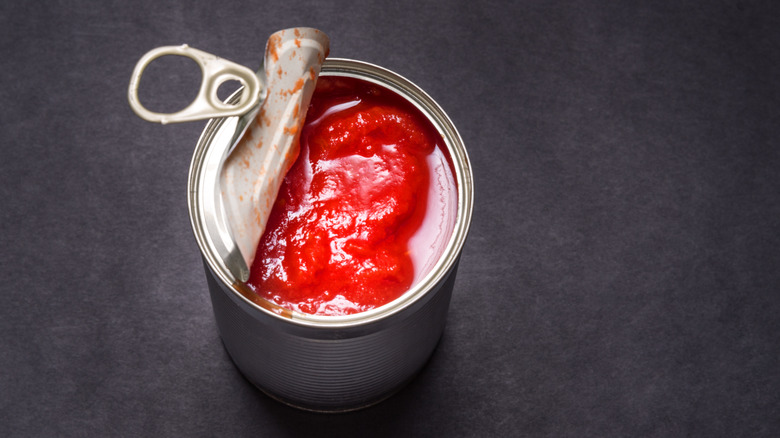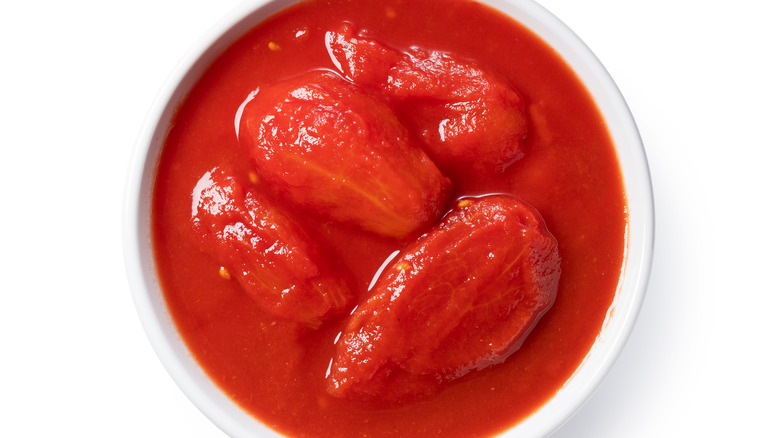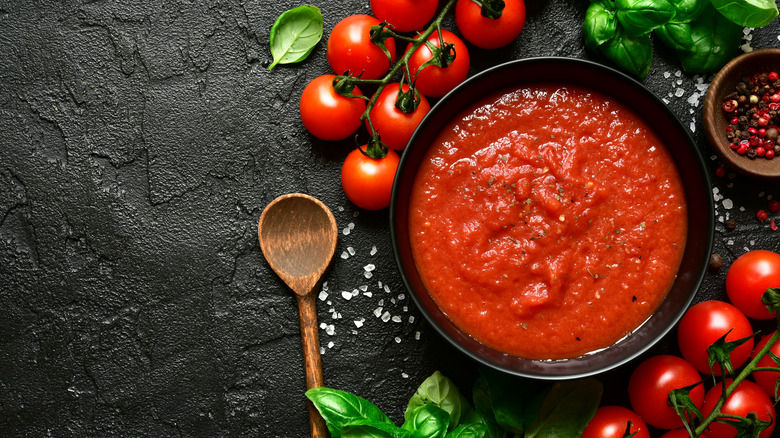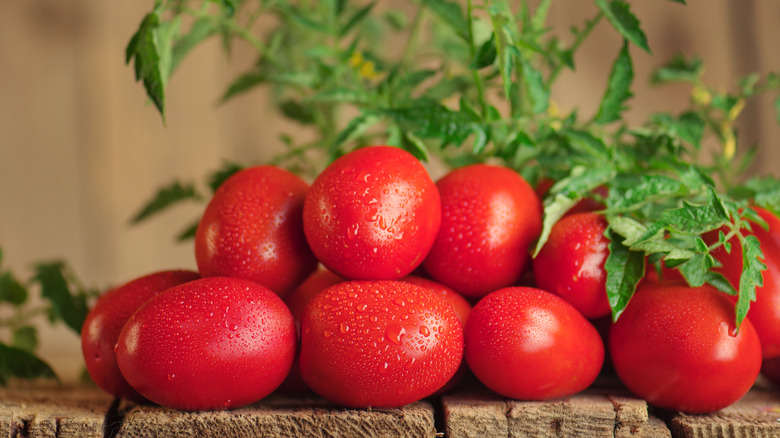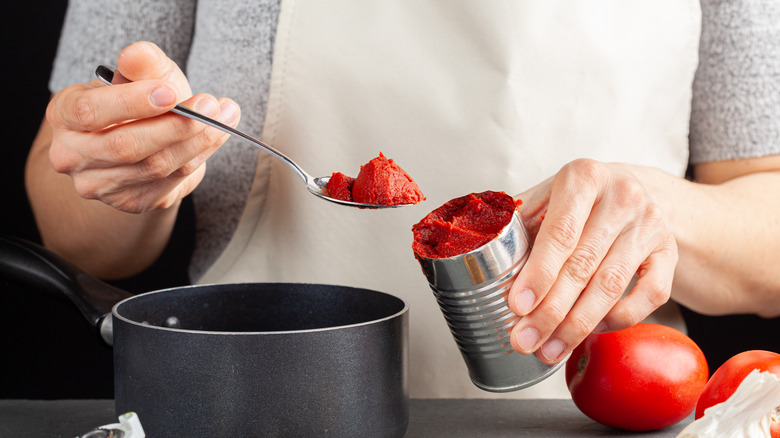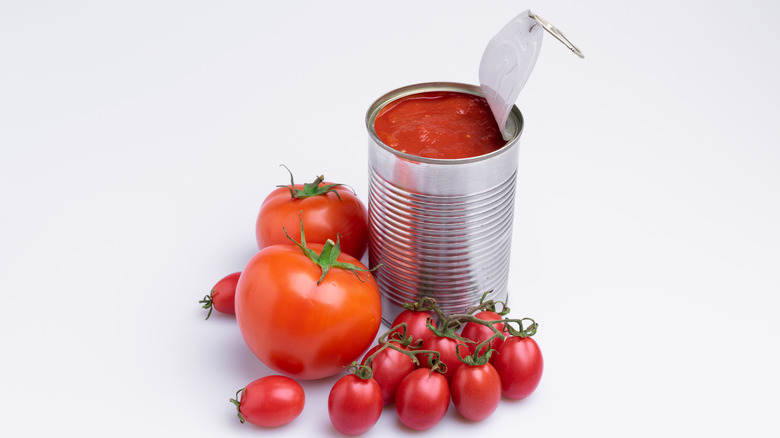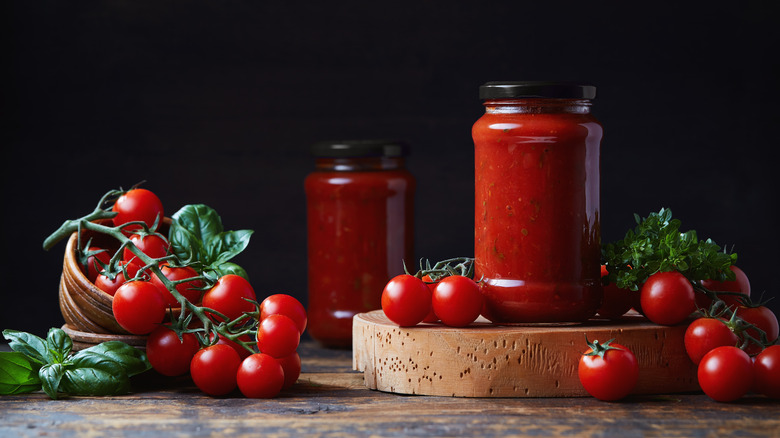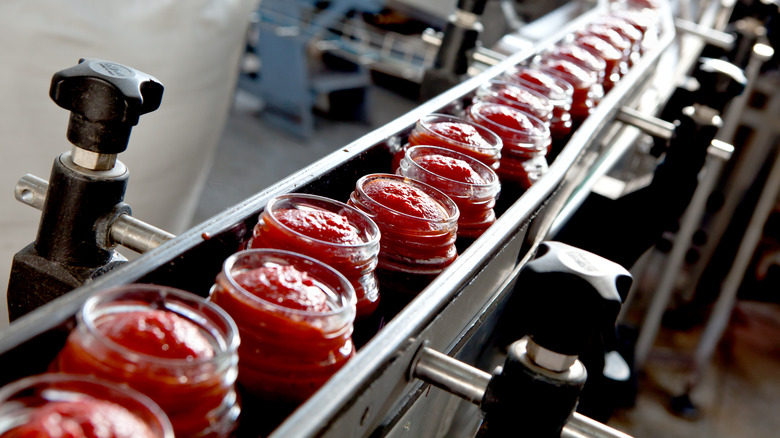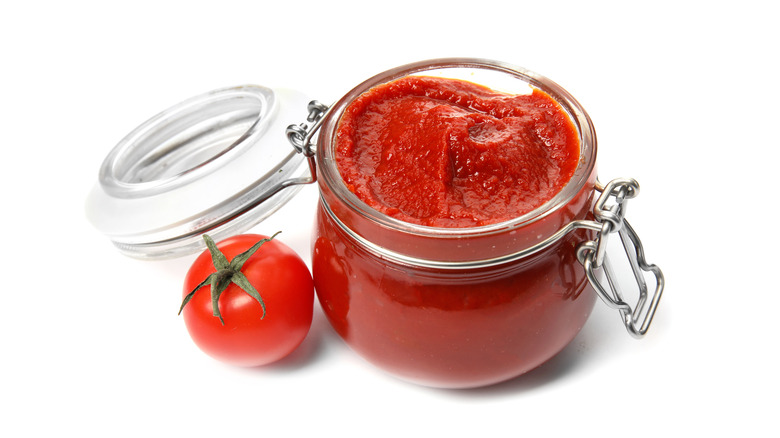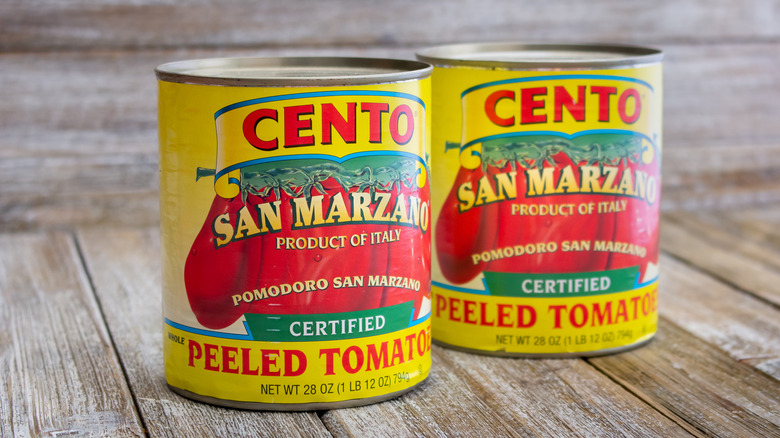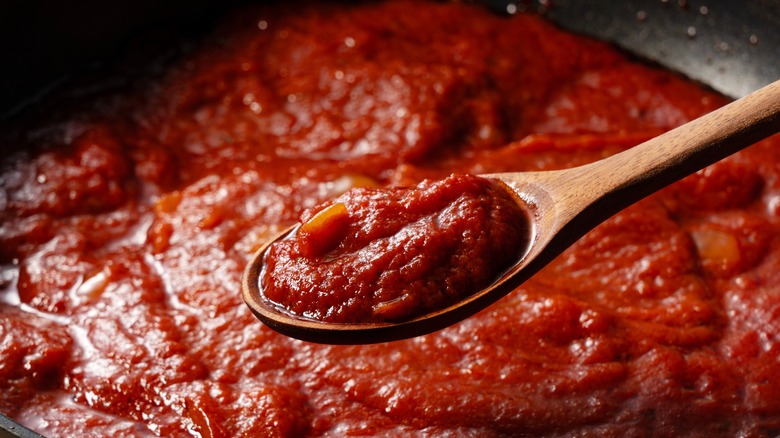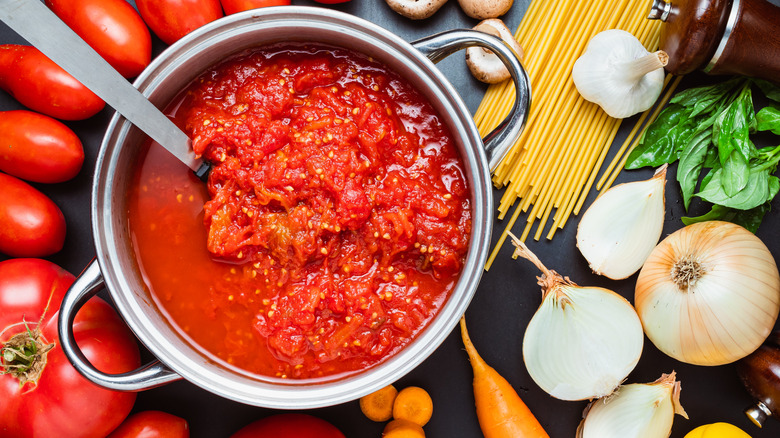Everything You Need To Know About Canned Tomatoes, Ever
Tomatoes are one of the most consumed foods in the world, grown in all corners of the globe and taking a feature role in virtually every kind of cuisine. Fresh tomatoes are juicy, vibrant, and sweet, but canned tomatoes are just as important in both home kitchens and professional settings, adding a different type of tomatoey goodness (and convenience) that impacts many dishes.
Sharing the health profile of their fresh counterparts, canned tomatoes are a great way to get nutrition and flavor into various dishes, from Spanish paella to Hungarian goulash, tomato soup to Mexican salsa. They are not just a backup option but a kitchen superstar in their own right, providing a unique depth of flavor to so many classic dishes.
Join us as we uncover everything you could possibly need to know about canned tomatoes — from navigating the different types to keeping them as fresh as possible once the can has been popped open and how to cook with them. These practical tips will help make sure you're able to use these tinned wonders to their full potential and enjoy them at their best, whether that's making a cozy dinner for one or creating a gourmet meal for a special occasion.
Types of canned tomatoes: whole vs. diced
Whole peeled tomatoes are one of the most common types of canned tomatoes available, making it worthwhile to always have a few tins of them in your pantry. This type can be turned into any of the other forms with a few minutes of preparation, so it makes sense to stock up on these. It also gives you the option of making a thicker sauce since you can drain some of the excess liquid off before using it.
Diced canned tomatoes have the distinct advantage of saving you time when preparing your dish. Assuming your final dish doesn't call for the tomatoes to remain whole, you will likely chop or crush your canned tomatoes at some point in the cooking process, so buying them pre-chopped seems like a convenient time-saver. Just be aware that they will not break down as much as whole tomatoes, which may not be ideal if you are making a smooth sauce.
Strained canned tomatoes, also known as tomato puree or passata, are the perfect choice if you are looking for a silky-smooth tomato option. If you are making a soup or creamy sauce and don't want to blend the whole thing at the end, adding strained tomatoes means there will be no tomato lumps lurking in your dish.
The final option is tomato paste. This is a more concentrated tomato product and is used to add depth of flavor in soups and sauces. While it is definitely worth having some tomato paste in your pantry, it cannot really be used in the same way as other canned tomatoes, so making sure you have a variety of different cans is a great way to cover all bases.
Types of canned tomatoes: paste, strained, and pureed
Nutritional profile of canned tomatoes
Canned tomatoes are a convenient way to get extra vegetables into your diet, which is great news for your health since they are bursting with nutrition. Technically a fruit, tomatoes are an incredibly rich source of lycopene, one of the most powerful antioxidants found in food. It has been shown to possibly reduce the risk of certain cancers and can protect against sunburn (via Skin Cancer Foundation). Perhaps surprisingly, canned tomatoes have more lycopene than fresh tomatoes and can be absorbed better by the body. This is because lycopene in fresh tomatoes is strongly held within the cell, and the processing of canned tomatoes releases it, making it more bioavailable.
Tomatoes also contain a wide range of important minerals and vitamins, earning them the title of a superfood. They contain vitamins A, C, and E, which all help contribute to a healthy immune system and general good health. They are also rich in the essential minerals potassium and folate, crucial for healthy blood pressure and cell function (via Healthline and Medical News Today).
Low in calories and sugar yet high in fiber, with 8% of your RDA in one can, tomatoes are an all-round fantastic food to incorporate into your daily meals. Bear in mind, however, that some brands of canned tomatoes may have added salt or sugar. Check the labels before purchasing, and steer clear of the ones with additives if you want to have as low of a glycemic impact as possible.
Are canned tomatoes cooked?
Before you prepare a dish using canned tomatoes, it may cross your mind if they are already cooked since the answer may affect how long you cook them in your recipe. The answer is yes: Canned tomatoes are already cooked during the canning process. Canned food undergoes the method of thermal processing to sterilize the food by destroying microorganisms.
In order to kill potentially dangerous bacteria and prevent any growth during the long shelf-life of the tomatoes, they are heated to a temperature above 200 degrees F, meaning the tomatoes are cooked in the process. This is the reason that canned tomatoes have a different flavor and texture from raw, fresh tomatoes, meaning that they cannot be used in place of fresh if the dish is not being cooked. It also means that, if you are in a hurry, heating canned tomatoes will take less time than cooking fresh tomatoes down completely.
Canned vs. fresh tomatoes: when to use each one
The question of whether to use fresh or canned tomatoes in your cooking is one that may not be as clear-cut as it seems. In general, we tend to think of fresh ingredients as being better than canned, but just as dried herbs can give a different flavor profile to a dish than their fresh counterparts, canned tomatoes have unique qualities that they can bring to your culinary creations.
If your tomato dish needs to be bright and zingy, fresh tomatoes should always be your go-to option. When in season, fresh tomatoes add a juicy sweetness that can't be matched, but out of season, they can be a different story. After a long journey to reach your kitchen, the texture and flavor may be lackluster over a short period of time.
Canned tomatoes, on the other hand, can be relied upon all year-round. They lend their flavor well to hearty, slow-cooked dishes such as casseroles and sauces, where the tomatoes take on flavors from other ingredients. They also come with the added convenience of very little preparation being needed.
The best approach is to use a mixture of fresh and canned tomatoes across your repertoire. Obviously, canned tomatoes are not going to be starring in your Caprese salad any time soon, but if your tomatoes need to be cooked, consider using fresh while they are in season and canned the rest of the year.
The flavor of canned tomatoes compared to fresh
In a blind taste test, surely most people would have no problem discerning between fresh tomatoes and canned. Although they can be used interchangeably in certain dishes, their flavors are very different, meaning you should give some thought to the final flavor of your dish before deciding which one to use.
Canned tomatoes, which are cooked and canned when they are perfectly ripe, have an intense flavor and add a deep umami element to dishes such as marinara sauce and stews. They take on flavors of herbs and spices well, especially if a dish is cooked for a long time.
Fresh tomatoes have a much more varied flavor profile. They can be sweet and juicy when perfectly ripe and often have a sharp, acidic element that can add a burst of zing to fresh dishes. When cooked, their sweetness intensifies, and cooked cherry or baby plum tomatoes can add a surprise zesty pop to sauces. The different varieties of fresh tomatoes also mean you can choose the best type to suit your particular dish, from sweet Sungold to earthy vine-ripened Roma.
How are canned tomatoes produced?
To produce quality canned tomatoes that preserve their rich flavor, an intricate process is required to get them from the vine to the grocery store. This begins with choosing the best varieties of tomatoes for canning, such as San Marzano, which has a lower acid content and thicker walls. They are picked at their perfectly ripened best, ensuring they are bursting with flavor and the richest nutritional value.
Once harvested, only the best tomatoes make the cut before being washed to remove dirt and bacteria. Canned tomatoes don't have skins, so they have to be blanched in hot water, making them easy to peel. They are then crushed, diced, or left whole, depending on the end product required.
The tomatoes are then added to their cans, along with a few additional ingredients, such as tomato juice, tomato paste, herbs, or garlic, before the cans are sealed to make them airtight. They are heated to preserve the flavor and extend their shelf-life before being rapidly cooled and packaged for distribution. The cans can then be distributed to grocery stores around the country, ready to make their way onto your pantry shelves and into your culinary masterpieces.
Keeping canned tomatoes fresh once opened
Though canned tomatoes have a long shelf-life, once the seal has been broken, they are no longer protected from air and potential contaminants, so some care needs to be taken to ensure they stay fresh for a few days. Storing them properly means they should retain their quality and nutrients until you are ready to use the remainder of the can.
Due to their acidic nature, it is important to transfer the contents of your open can of tomatoes to another container to prevent the acid from reacting with the aluminum can. Transferring to a glass or plastic container with an airtight lid will prevent a metallic taste from being imparted onto the tomatoes and will create a barrier to air and moisture.
Once opened, you must store the tomatoes in the refrigerator rather than at room temperature. This will slow the growth of any bacteria and keep it fresher for longer. Properly stored, an opened can of tomatoes should last for five to seven days in the fridge. However, as with all food, if you notice any signs of spoilage or an unusual smell, it's best not to take a chance and discard them.
How long do canned tomatoes last?
One of the most convenient aspects of canned tomatoes is their long shelf-life. It means you can stock up on them in your pantry and not need to worry too much about them going stale, especially if you rotate your canned goods. But just because they can be eaten years after purchasing them doesn't mean they should be.
In general, high-acid food such as tomatoes will be at their best for around 18 months after canning. You should aim to eat your tomatoes within this time period for the optimum flavor and texture. Beyond this point, they will still be safe to eat, but the quality may start to deteriorate.
It is important to note that, unlike perishable food, canned foods do not have an expiration date after which the food is unsafe to eat. Instead, a 'best before' date will give a rough guide as to when the product will taste best. To increase the longevity, store your cans in a cool, dry spot away from direct sunlight.
Once opened, of course, the date on the can is irrelevant, and you should store your tomatoes in the fridge and eat them within a week. If you need them to last longer, pop them in the freezer in a plastic container or zip-top bag, where they will keep safely for many months.
Tips for cooking with canned tomatoes
Canned tomatoes are such a useful pantry staple and can be used as a base for many different types of dish. While they are easy to cook, there are a few tips that can help boost their flavor and take your culinary masterpieces up a few notches.
Tomatoes pair brilliantly with aromatics such as onions and garlic, making a tasty base for a variety of classic dishes across many cuisines, from pasta sauce to chili con carne. Adding a pinch of sugar can bring out the sweetness of the tomatoes and balance out any acidity. Herbs and spices are also a crucial addition to canned tomatoes — choose basil or oregano for Mediterranean flavors and cumin or chili flakes for something a bit spicier.
In most cases, canned tomatoes will benefit from being simmered slowly, allowing the sauce to reduce and absorb all the additional flavors. This is the key to transforming a simple can of tomatoes into a rich, delicious sauce or base for a more substantial dish. Make sure to season well with salt and black pepper to round your dish off and enhance the tomato flavor, allowing the canned tomatoes to shine through.
Dishes to use canned tomatoes in
Canned tomatoes can lend their hand to hundreds of recipes across virtually every cuisine, but there are certain standout dishes that spring to mind that showcase the versatility and deep flavor of these pantry staples. Pasta sauces, from marinara to Bolognese, feature tomatoes heavily, and the canned version is usually the best choice. Adding a variety of herbs can lift the tomatoes and give a fresh twist to these classic Italian options.
In Mexican cuisine, canned tomatoes are used as a base for chili, allowing the tomatoes to absorb delicious spices as the pot simmers away. They can also be used as an alternative to fresh tomatoes in enchiladas and salsa.
To liven up grilling season, canned tomatoes can be used to make a homemade barbecue sauce, perfect for slathering on ribs or pulled pork. Or reduce down a can of tomatoes with Worcestershire sauce and a few spices for a delicious alternative to bottled ketchup, sans sugar and nasty additives.
No matter which global cuisine has inspired your cooking, canned tomatoes are an invaluable ingredient that can add flavor to many dishes and stand in for fresh tomatoes when they are out of season. Make sure to grab a few cans on your next trip to the store to ensure you're prepared for your next gastronomic adventure.
Where to buy canned tomatoes
As a pantry staple, canned tomatoes are available in virtually every supermarket and grocery store, which is ideal if you want to grab a can on the way home from work to whip up a quick midweek meal. But if you are looking for a higher quality tomato than those found in your local grocery store, there are a few options to consider.
If your love of tomatoes comes from a trip to Italy, consider buying authentic Italian canned tomatoes that have been imported from Europe. San Marzano tomatoes are considered some of the best in the world, and those grown in Naples have Protected Designation of Origin, meaning you will need to buy imported cans if you want to enjoy the real thing. As well as having the rich, concentrated tomato flavor associated with San Marzano, Italian canned tomatoes, unlike those produced in the United States, do not have calcium chloride added to them. This means they can break down into a sauce consistency much more easily.
To find imported or organic tomatoes, you may have luck at your local specialist grocery or health food store. Otherwise, there are many online stores, including Amazon and gourmet food websites, where a variety of specialist options are available. You will have to pay a premium compared to the supermarket brands, but the difference in quality will be apparent the next time you whip up your signature dish.

